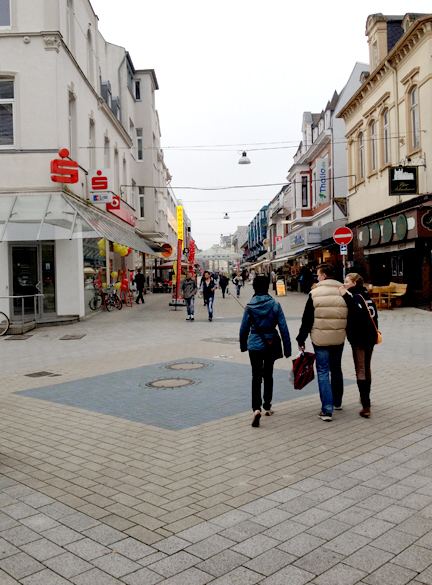District Urban district Time zone CET/CEST (UTC+1/+2) Population 81,411 (31 Dec 2008) | Elevation 2 m (7 ft) Postal codes 26351–26389 | |
 | ||
Weather 8°C, Wind NW at 10 km/h, 80% Humidity University Jade University of Applied Sciences Points of interest Deutsches Marinemuseum, Kaiser Wilhelm Bridge, Küstenmuseum Wilhelmshaven, JadeWeserPort, Bunker Museum Wilhelmshaven | ||
Wilhelmshaven (meaning William's Harbour; [vɪlhɛlmsˈhaːfn̩]) is a coastal town in Lower Saxony, Germany. It is situated on the western side of the Jade Bight, a bay of the North Sea. Wilhelmshaven is the centre of the "JadeBay" business region (which has around 330,000 inhabitants).
Contents
- Map of Wilhelmshaven Germany
- History
- World War II
- Since 1945
- Wilhelmshaven today
- Sights
- People
- Twin towns Sister cities
- References
Map of Wilhelmshaven, Germany
The adjacent Lower Saxony Wadden Sea National Park (part of the Wattenmeer UNESCO World Natural Heritage Site) provides the basis for the major tourism industry in the region.
History
The Siebethsburg castle, built before 1383, operated as a pirate stronghold; the Hanseatic League destroyed it in 1433. Four centuries later, the Kingdom of Prussia planned a fleet and a harbour on the North Sea. In 1853, Prince Adalbert of Prussia, a cousin of the Prussian King Frederick William IV, arranged the Jade Treaty (Jade-Vertrag) with the Grand Duchy of Oldenburg, in which Prussia and the Grand Duchy entered into a contract whereby Oldenburg ceded 3.13 square kilometres (1.21 square miles) of its territory at the Jade Bight to Prussia. In 1869 King William I of Prussia (later also German Emperor) founded the town as an exclave of the Province of Hanover and a naval base for Prussia's developing fleet. All the hinterland of the city remained as part of the Duchy of Oldenburg.
A shipbuilding yard developed at Wilhelmshaven, the Kaiserliche Werft Wilhelmshaven (Wilhelmshaven Imperial Shipyard). On 30 June 1934 the "pocket battleship" Admiral Graf Spee was launched at Wilhelmshaven.
In 1937 Wilhelmshaven and Rüstringen merged and the united city, named Wilhelmshaven, became a part of the Free State of Oldenburg.
World War II
In World War II (1939-1945), Allied bombing destroyed two thirds of the town's buildings. On 28 April 1945, the Canadian First Army captured Emden and Wilhelmshaven, Germany, and took the surrender of the entire garrison, including some 200 ships of the Kriegsmarine. The Poles remained as part of the allied occupation forces until 1947. During World War II Alter Banter Weg (No. 1582 Wilhelmshaven) functioned as a subcamp of the Neuengamme concentration camp.
Since 1945
In 1947 the city council decided to seek a new emblem for the city. After the Control Commission for Germany - British Element (CCG/BE) had rejected several designs, Wilhelmshaven selected the image of a Frisian warrior (Rüstringer Friese), designed after a nail man erected in the city during the First World War to collect war donations.
Between 1947 and 1972 Wilhelmshaven was the home of PRINCE RUPERT SCHOOL, a comprehensive boarding school for children of British Army and RAF personnel serving with BAOR. The school relocated to Rinteln in 1972. There is an active association of former Wilhelmshaven pupils called The Wilhelmshaven Association.
Wilhelmshaven today
Wilhelmshaven is Germany's only deep-water port, and its largest naval base. The benefits of the deep shipping channel were already recognised at the end of the 1950s with the construction of the first oil tanker jetty. Wilhelmshaven has been the most important German import terminal for crude oil ever since. Pipelines from here supply refineries in the Rhine-Ruhr region and Hamburg. Other major business operations followed, and constructed jetties for crude oil and oil products, coal, and chemical products.
One of the main industrial sectors in Wilhelmshaven is the port industry with its wharfs, sea port service companies, service providers and repair businesses, transhipment and handling businesses, and agencies, etc. The "JadeWeserPort" – Container Terminal Wilhelmshaven (CTW) and the development of the neighbouring Freight Village provide prospects for employment in areas such as logistics and distribution.
Another element of the "Wilhelmshaven energy hub" programme is the chemical industry (refinery, PVC, and chlorine gas production), as well as power generation (two coal-fired power stations, wind power).
The German defence forces (German Navy, navy arsenal, logistics centre) together with the public sector, are the main pillars of the local employment market.
Sights
Every year in the first days of July, the big "Weekend on the Jade" event attracts hundreds of thousands of visitors to the big port, the southern beach and the navy arsenal. Another big event takes place at the end of the sailing season at the beginning of October when two dozen large sailing ships dock in Wilhelmshaven as part of the "JadeWeserPort Cup".
People
Twin towns – Sister cities
Wilhelmshaven is twinned with:
